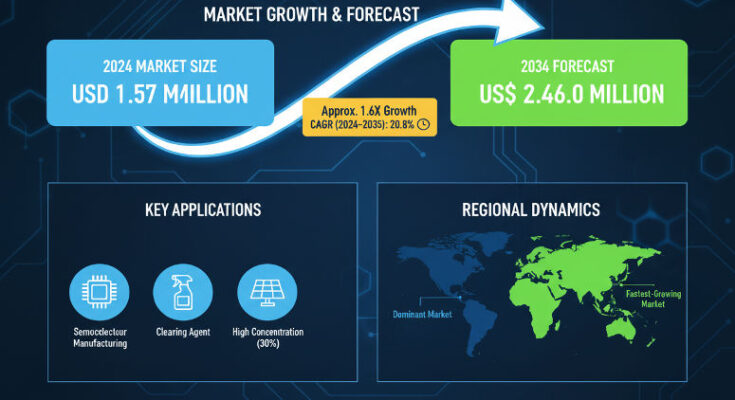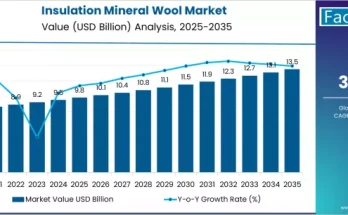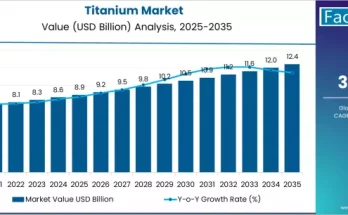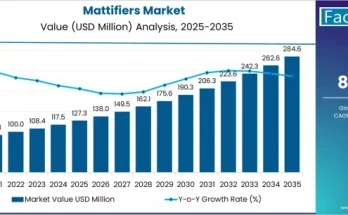In an age where micro-precision and ultra-clean surfaces are essential, the Electronic Grade Hydrogen Peroxide (EGHP) Market is quietly becoming one of the most critical components in the semiconductor, photovoltaic, PCB, and display manufacturing value chains. Designed to deliver extremely low contamination, superior oxidizing power, and reliable cleaning for delicate substrates, EGHP is surging in demand. Recent data places its global valuation at approximately US$ 1.57 billion in 2024, with projections pointing to US$ 2.46 billion by 2034, growing at a CAGR of around 4.6%.
Market Size, Forecast & Growth Drivers
The demand for EGHP is underpinned by a number of powerful trends. As semiconductor foundries ramp up production and move to smaller node geometries, the importance of wet-chemical processing—etching, cleaning, surface preparation—intensifies. Electronic manufacturers require hydrogen peroxide of the highest purity so that any trace metals, organic residues, or particulate contamination can be virtually eliminated. This is not merely about cleanliness; defects in nanoscale devices translate directly to yield loss and higher costs.
Photovoltaic manufacturing is another strong driver of growth, with EGHP used extensively in cleaning and oxidizing processes for solar cells. As solar adoption accelerates globally, demand for high-purity chemicals in PV fabs grows in parallel.
Other growth promoters include increasing fab capacities (especially in East Asia), regulatory pressures to reduce contamination and environmental impact, and ongoing efforts by key industry players to innovate both in purity levels (lower ppb/parts per trillion thresholds) and in concentration formulations.
Application & Segment Insights
EGHP is used primarily in two major functions: Oxidizing & Cleaning Agents and Etchants. The oxidizing/cleaning segment dominates, projected to represent roughly 69% of the global market value by 2034. This is due to extensive use in semiconductor wafer preparation, PCB etching, and solar cell cleaning, where the highest purity and minimal residue are essential.
Among applications, printed circuit board etching, semiconductor wafer cleaning, and photovoltaic/solar cell manufacture are the key consumers. By 2034, the photovoltaic application alone is expected to generate over US$ 600 million in annual demand for EGHP.
Concentration grades and contamination levels also matter. EGHP grades above certain concentration thresholds, with contamination levels at sub-ppb or ultra-low ppb, are drawing increasing premium valuation as node scaling challenges intensify.
United States & Europe: Regional Trajectories
United States: The U.S. market for electronic grade hydrogen peroxide is showing robust growth, with a forecasted CAGR of about 5.6% through 2034. With strong government support for semiconductor manufacturing, regulatory incentives, and high demand for reliable chemical supply chains, American fabs are investing heavily in high-purity wet chemicals. The U.S. is expected to capture a substantial portion of the North American demand, driven by both domestic fabs and imports necessary for display and PV manufacturing.
Europe: In Europe, demand is somewhat more moderated but steadily rising. European players are particularly focused on compliance, traceability, environment-friendly manufacturing and carbon footprint reduction. Producers of EGHP in Germany, France, and the UK are innovating in packaging, process optimization, and supply reliability. Europe’s demand is also driven by its automotive electronics sector, growing solar installations, and increasing regulation around chemical purity and manufacturing waste.
Recent Trends & Innovation Signals
A few developments merit special attention:
-
Key producers are expanding capacity and upgrading purification and filtration technologies to meet ultra-low contamination thresholds.
-
Startup and established firms alike are launching new grades of EGHP with lower trace metal content and more stability, to serve high-end semiconductor and display fabs.
-
There is rising interest in sustainable approaches—using renewable energy in production, reducing waste, and improving safety in the handling and transportation of highly concentrated peroxide formulations.
-
Innovations in intelligent packaging and supply chain traceability are emerging, allowing customers (fabs, PCB shops, PV manufacturers) to monitor purity, storage conditions, temperature, and contamination in transit, thereby reducing batch rejections.
Key Players & Competitive Landscape
Major global manufacturers in the EGHP space include Mitsubishi Gas Chemical, Arkema, Taekwang Industrial, Solvay, Evonik Industries, Santoku Chemical, and Grasim Industries. Several of these companies are investing in capacity expansions, especially in Asia, to meet fab demand and to localize supply chains.
Differentiation today comes from purity levels (contamination limit), concentration grade, reliability & stability, packaging, supply assurance, and regulatory compliance. Firms that can reliably meet the <1 part per billion or better contamination levels will command premium pricing, especially as advanced node fabs become more complex.
Challenges & Restraints
Still, the EGHP market faces real headwinds. Safety and handling of hydrogen peroxide—especially at high concentration and low contamination—is challenging, and regulatory compliance adds cost. Stamp-specific purity standards, traceability, clean room compatible supply chains, and handling protocols are strict, and noncompliance or contamination can lead to severe losses for both producers and end users.
Furthermore, supply chain bottlenecks—raw material quality, transportation, import/export regulations—can restrict availability or increase costs. Concentration and grade variants impose additional processing and quality control costs.
Browse Full Report: https://www.factmr.com/report/2954/electronic-grade-hydrogen-peroxide-market
Outlook & Strategic Implications
Looking forward, the EGHP Market Forecast through 2034 suggests steady, meaningful growth. Key opportunities lie in:
-
Further purity improvements to support next-gen semiconductors (e.g. sub-5nm, EUV nodes)
-
Localizing supply chains in Asia, North America, and Europe to reduce lead times, regulatory friction, and environmental cost
-
Sustainability and green manufacturing practices becoming a differentiator
-
Broadening EGHP use in emerging applications like advanced sensors, MEMS, LEDs, and next-generation displays
Companies that can balance high purity, safety, sustainability, and cost efficiency will shape the top tier of this market.
Editorial Conclusion
The electronic grade hydrogen peroxide market might not grab headlines as explosively as semiconductors themselves, but it is a critical foundation without which modern chip, display, and photovoltaic industries cannot build reliable, high-yield products. Its rise is quietly essential to the next wave of technological progress. For manufacturers, investors, and chemical suppliers, EGHP represents both a challenge in precision and an opportunity in scale and specialization.



